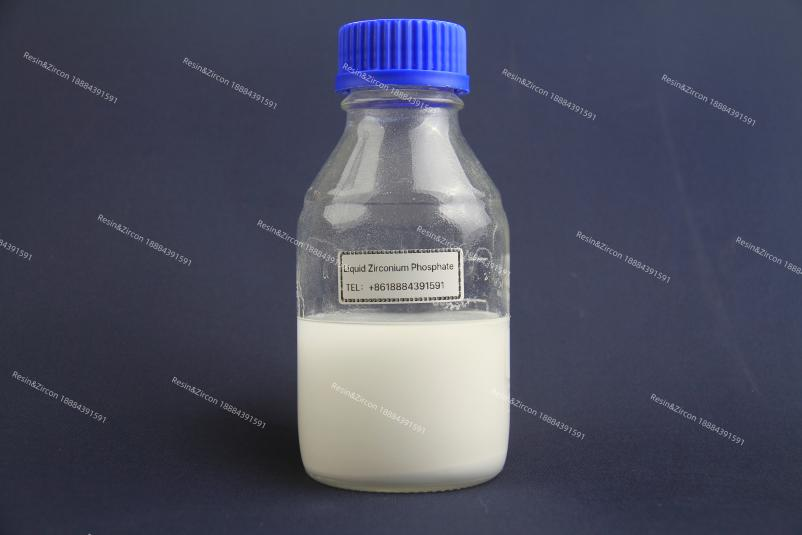Liquid Zirconium Phosphate
Liquid zirconium phosphate is more flexible in use and is a functional material with unique chemical properties for special situations.

n Scope of Application:
1. Catalysis
-Acid catalysis: The layered structure and surface acidic sites (Brønsted acid and Lewis acid) of zirconium phosphate make it a solid acid catalyst for esterification, alkylation, cracking and other reactions, which can replace traditional liquid acids (such as sulfuric acid) and reduce corrosion and pollution.
-Photocatalysis: used to degrade organic pollutants or produce hydrogen by photolysis of water by doping metals (such as Ti, Ag) or combining with semiconductors (such as TiO₂).
2. Ion exchange and adsorption
-Heavy metal removal: The Zr-O-P skeleton of layered zirconium phosphate has strong selective adsorption on Pb²⁺, Cd²⁺ and other heavy metal ions, which is used in wastewater treatment.
-Radioactive nuclide capture: high adsorption capacity for UO₂²⁺, Cs⁺, etc., and applied in nuclear waste treatment.
3. Energy materials
-Proton-conducting membrane: The interlayer acidic group (-PO₄H) of zirconium phosphate maintains proton conductivity at high temperatures and is used as an electrolyte material for fuel cells (such as PEMFC).
-Lithium/sodium ion batteries: as electrode materials or solid electrolyte additives to improve ionic mobility and thermal stability.
4. Bio-medicine
-Drug release: The layered structure can intercalate drug molecules (such as antibiotics, anticancer drugs) and control the release through pH response.
-Antibacterial materials: The synergistic action of Zr⁴⁺ and phosphate inhibit bacterial growth and are used in coatings or medical composites.
5. Composite material reinforcement
-Polymer modification: nano zirconium phosphate is dispersed in polymer matrix (such as epoxy resin, polyethylene) to improve mechanical properties, flame retardancy and gas barrier properties.
6. Sensors
-Use its ionic selectivity or surface acidity to construct pH sensors or gas (such as NH₃) sensitive elements.
n Product features
-Colloid dispersion system: Nanoparticles are stabilized by ultrasound or surface modification (e.g., PEG) for spraying or impregnation film formation.
-Sol-gel precursor: prepared by controlling hydrolytic condensation (e.g. ZrOCl₂ + H₃PO₄) for coating or low temperature sintering.
-Liquid zirconium phosphate should be prevented from excessive hydrolysis or gelation (pH and concentration are key).
n Recommended Additions
1.1 Solid acid catalysts:
The amount of liquid precursor (such as sol) added, based on Zr element, is usually 0.1~5 mmol/L reaction system.
Photocatalytic composites (e.g., TiO₂/ZrP): The doping amount of zirconium phosphate is generally 0.5~10% of the matrix mass.
1.2 Polymer composites
Enhancement/flame retardant modification:
l The amount of nano zirconium phosphate added is 0.1~5 wt% of the polymer matrix (more than 5% may be difficult to disperse).
l Adding 1~3 wt% epoxy resin can significantly improve the mechanical strength and flame retardancy.
l Proton exchange membrane (e.g., Nafion/ZrP): the addition amount is usually 3~20 wt%, too high may lead to membrane brittleness.
1.3 Energy materials
Solid electrolyte additives:
In lithium/sodium ion batteries, the addition amount is 1~5 wt% of the electrode material.
Fuel cell proton membrane: ZrP is 5-15 wt% in the composite membrane (too high will reduce flexibility).
1.4 Bio-medicine
Drug loading: The mass ratio of zirconium phosphate to drug is usually 1:0.1~1:1 (depending on the size of drug molecules and interlayer capacity).
Anti-corrosion coating: when the sol is sprayed, zirconium phosphate accounts for 2~10 wt% in the coating.
1.5 Adsorption and ion exchange
- Wastewater treatment: When liquid, it is usually 0.05~1 vol% according to the solid content of zirconium phosphate.